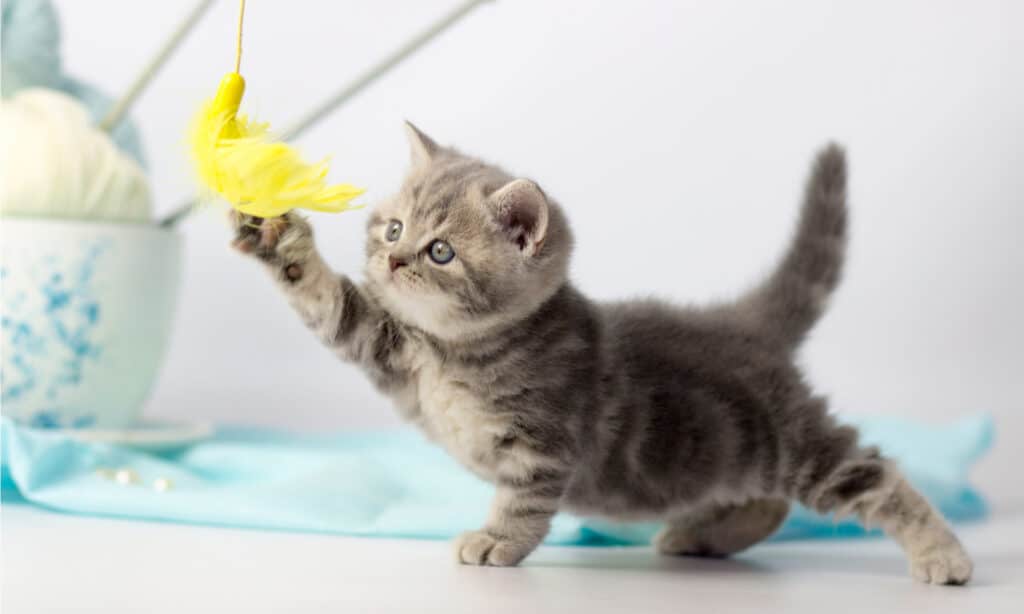Did you know there are two different “outdoor cats” types? There are stray cats, and then there are “feral cats.”
Lost or abandoned cats are considered to be stray cats at some point in their life, being in contact with humans and domesticated. Therefore, socializing with them would not be that hard, for they should still hold some memories of their past domesticated life.
Feral cats have never had human contact (as in, they were born outside). Otherwise, they have been on the streets long enough to forget their domesticated customs and ways. A feral cat is a stray cat that has been forgotten.
So, can I socialize a feral cat? The easy answer to this is yes, you can.
However, socializing a feral cat is a very time-consuming process that will take an enormous amount of patience. Yet, if you hold out until the end, you will find it very rewarding. Remember that the animals’ age will make a big difference if you attempt to do this. Feral kittens are going to be easier to break than older feral cats.

Do they want my attention?
©Nynke van Holten/Shutterstock.com
Signs of a Feral Cat
The main interception point for this will be their body language. A feral cat is going to be fearful of you. Think of them like you would a squirrel. They are curious and watchful. Road runners of the trees they will run if you approach them. But if backed into a corner, you will wish you had not done so. A feral cat will surely make every attempt to run from you.
They will run and hide and usually are found hiding in small enclaves. Enclosed quarters give them a sense of security. Finding them hiding in small spaces is a widespread occurrence.
Another common trait you will see is their kindness. It will lack. They have no interest in you and want nothing to do with you. Believe me when I say they will stop at nothing to inform you.
Stray Pet Advocacy explains this perfectly when it says,
“You need to allow her to be afraid, you can’t lose your patience with her, and you can’t rush her to “conform” to your expectations. If you can do all that, you have what it takes to help this cat. You have a feral point of view.”
10 Ways to Socialize a Feral Cat
1. First Off, Make Sure It Is FERAL
If you want to help socialize a feral cat, make sure you have one. Look for things like fear. This cat should be afraid of you. They are usually quiet, not trying to draw attention to themselves. They WILL NOT approach you even if you present food. In most cases, they will wait for you to drop the food, only inspecting it after you have left the area.

Feral cats are VERY fearful of you.
©Katamount/Shutterstock.com
2. Accept the Fact It Is a FERAL CAT
The cat you have just brought in is not your grandma’s 13-year-old lazy house cat that likes to eat cheese. This is a WILD animal and will react as such. Imagine getting a tiger into your home. Envision how they would act. Now apply that but to an animal ten times smaller.
All of their instincts are going to be the same. The fight for food, the stealth, and the phrase seen but not heard. They will be territorial over the space they consider their safe zone and fight to death if they think they are in harm’s way.
If you are still struggling with what kind of cat you are looking at, check out our article Types of Feral Cats for further details on how to tell the difference between these and any other form of cat.

Little kittens in a cage of a shelter for homeless animals.
©Giordano66/Shutterstock.com
3. Understanding Their Behavior
A feral cat is going to act just like a feral cat. Once you accept this, it will be easier to understand what they are doing and why. Knowing why they behave the way they do will help you determine how to fix that behavior.
Our article Understanding the 3 Types of Feral Cats will help you navigate the behaviors of a wild cat if you need more coaching.
Although you want to fix their behavior, this does not mean turning them into a domesticated house cat. A feral cat will NEVER be able to be considered a house cat, not even if you have cared for it for an extended period. In the end, it will inevitably always be a wild animal. You are merely trying to tame it a bit. Tame it enough so you can feed it, and it can feel comfortable enough to come out and eat. You want to show that you have a safe space. The goal is to help them live, not become their life merely.

Kitten playing with yarn.
©Katrin Baidimirova/Shutterstock.com
4. Prepare Your Home. Please Give Them a Safe Space
First, you want to give them an area that provides privacy — a space where they can “get away” from you and everyone else involved. You want to give them a place they feel safe in. Essentially, you are providing them with extra hiding areas so they can choose the one they feel most comfortable in.
They should have easy access to their food, water, and litter within this safe space. You cover basic instincts by providing them with a safe eating space. Therefore, you are providing them with means for their survival. There is no more significant bond you can create with something than by giving it a source of food.

Cute young kitty playing inside a cardboard box.
©John Hanson Pye/Shutterstock.com
5. Get Vet Care
An essential part of caring for a feral cat is ensuring they are healthy. Undeniably, this is one of those “hard parts” we discussed. Glide on those gloves because you are going to need them. You must capture the cat (I suggest using a pet carrier). These can be found at any one of your local pet stores. I have also provided a link to one found on Amazon here.
Capture the cat and then take it to a vet of your choosing. Stray Pet Advocacy has a great article that discusses socializing a feral cat. In their report, they say without a doubt that you want to “Check for worms and parasites (fleas and ticks), test for FeLV and FIV, ringworm and lice. Spay or neuter as soon as possible.”
Nevertheless, get a diagnosis of excellent health, and the fun begins.

Getting checked at the vet.
©santypan/Shutterstock.com
6. Bond With Them
Introduce them to their newfound safe space. Show them where their stomping grounds are—making sure to give them time in their area to settle in. Let them have the time to take in their surroundings. It is crucial that you back away from them during this process. At first, they do not like you and cannot fully relax in that space if you are lurking. Back away and give them a day or two. Let them search out their hiding spots and spend time scoping out their new world.
They need to know they will have access to food and water, so make sure those are available. Coincidentally, this is the next step to bonding.
The easiest way to any animal’s heart is food. For instance, most animals are very food-motivated. Food is a NEED for survival, and finding it is instinct. Your animal will never NOT want a treat.
It is through their love of food that their bonding initially starts. This is where their trust begins to form.

Looking at its food.
©Jaromir Chalabala/Shutterstock.com
7. Build Trust
No change will be seen until trust is built. Without trusting you, their guard will not be let down. As mentioned above, FOOD is a great way to earn that trust. By providing them with a basic instinct, they will learn to rely on that.
Reiterating that it will NOT happen immediately, but eventually, this cat will learn that no strings are attached to your free food. They will start to seek you out for this source of energy.
When thinking of preserving energy, once it is understood (by them) that they can close their eyes and get some shut-eye without being on high alert for a threat. They will start to enjoy their situation more.
Sleep deprivation makes humans unbearable and sick. I can only imagine it does the same to our four-legged furry friends.
The Merrimack River Feline Rescue Facility has a good article called 6 Steps to Taming a Feral Cat. In this article, the first number on their list for taming a feral cat is letting the cat make the first move. “Ignoring an animal you are trying to socialize with may seem silly advice…. Snubbing a semi-feral kitty will pique its curiosity and force it to make the first move.”

Snuggle Time.
©Creative Cat Studio/Shutterstock.com
8. Socialize Them
An animal gathers a lot from the tone of our voice. It is not always about what it is that we are saying. Sure, words do matter. But speak to them in general. Talking is a form of companionship. Companionship and friendship run along the same lines.
They will soon learn to listen to your voice. They might even start to gather when they hear you, especially if you talk to them whenever you provide them with a meal. They will come when you call.

Bengal cats have a high metabolism and require a high-protein diet.
©PHOTOCREO Michal Bednarek/Shutterstock.com
9. Unfriendly Personality Traits Do Not Mean You Are Not Able to Socialize
Just because a Feral Cat chooses to be unfriendly does not necessarily mean they are anti-social. Just like some people are grumpy and not friendly, so are animals. Suppose you can interact — even if it is just a few seconds of eye contact while you are filling their bowl. Consider that a win!
Socializing feral cats is an exceptionally long process. It takes a lot of time to build up their trust. Just because they want nothing to do with you does not mean what you are doing is not working. Suppose you can feed them and keep them generally healthy. Then, you make a difference even if they growl in your direction every time you move.
Oscar the Grouch was not the happiest puppet either.

They like to hide for various reasons, including relaxing without being disturbed.
©Africa Studio/Shutterstock.com
10. Understand If It Is Too Late to Socialize a Feral Cat
If you feel you have been working with a specific animal for some time, you are getting nowhere. Keep in mind the age of the cat. Kittens who are younger than four months are going to be easier to socialize with.
Older cats who have spent more time being “feral” will have more difficulty learning to socialize differently than they always have. As the saying goes, you can’t teach an old dog new tricks. Which you can. It is just twice as hard and takes twice as long. But it is possible.

Some are just unsocial beings.
©Alexander Sobol/Shutterstock.com
Recap: How to Socialize a Feral Cat
In the end, we have found it IS possible to socialize a feral cat. Depending upon the age and personality of the cat. To socialize feral cats, they need to learn they are safe. They cannot know anything until they are in a calm state. They need to understand you are safe for the same reasons. Then, they need to be interested to the point that they want to learn more, inspect you, and cooperate with your shenanigans.
| Rank | How to Socialize a Feral Cat |
|---|---|
| 1 | First Off, Make Sure It Is FERAL |
| 2 | Accept the Fact It Is a FERAL CAT |
| 3 | Understanding Their Behavior |
| 4 | Prepare Your home, Give Them a Safe Space |
| 5 | Get Vet Care |
| 6 | Bond With them |
| 7 | Build Trust |
| 8 | Socialize Them |
| 9 | Unfriendly Personality Traits Do Not Mean You Are Not Able to Socialize |
| 10 | Understand If It Is Too Late to Socialize a Feral Cat |
Thank you for reading! Have some feedback for us? Contact the AZ Animals editorial team.








